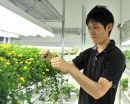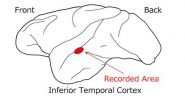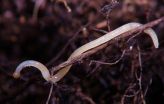(Press-News.org) An ultrasensitive biosensor made from the wonder material graphene has been used to detect molecules that indicate an increased risk of developing cancer.
The biosensor has been shown to be more than five times more sensitive than bioassay tests currently in use, and was able to provide results in a matter of minutes, opening up the possibility of a rapid, point-of-care diagnostic tool for patients.
The biosensor has been presented today, 19 September, in IOP Publishing's journal 2D Materials.
To develop a viable bionsensor, the researchers, from the University of Swansea, had to create patterned graphene devices using a large substrate area, which was not possible using the traditional exfoliation technique where layers of graphene are stripped from graphite.
Instead, they grew graphene onto a silicon carbide substrate under extremely high temperatures and low pressure to form the basis of the biosensor. The researchers then patterned graphene devices, using semiconductor processing techniques, before attaching a number of bioreceptor molecules to the graphene devices. These receptors were able to bind to, or target, a specific molecule present in blood, saliva or urine.
The molecule, 8-hydroxydeoxyguanosine (8-OHdG), is produced when DNA is damaged and, in elevated levels, has been linked to an increased risk of developing several cancers. However, 8-OHdG is typically present at very low concentrations in urine, so is very difficult to detect using conventional detection assays, known as enzyme-linked immunobsorbant assays (ELISAs).
In their study, the researchers used x-ray photoelectron spectroscopy and Raman spectroscopy to confirm that the bioreceptor molecules had attached to the graphene biosensor once fabricated, and then exposed the biosensor to a range of concentrations of 8-OHdG.
When 8-OHdG attached to the bioreceptor molecules on the sensor, there was a notable difference in the graphene channel resistance, which the researchers were able to record.
Results showed that the graphene sensor was capable of detecting 8-OHdG concentrations as low as 0.1 ng mL-1, which is almost five times more sensitive compared with ELISAs. The graphene biosensor was also considerably faster at detecting the target molecules, completing the analysis in a matter of minutes.
Moving forward, the researchers highlight the potential of the biosensor to diagnose and monitor a whole range of diseases as it is quite simple to substitute the specific receptor molecules on the graphene surface.
Co-author of the study Dr Owen Guy said: "Graphene has superb electronic transport properties and has an intrinsically high surface-to-volume ratio, which make it an ideal material for fabricating biosensors.
Now that we've created the first proof-of-concept biosensor using epitaxial graphene, we will look to investigate a range of different biomarkers associated with different diseases and conditions, as well as detecting a number of different biomarkers on the same chip."
INFORMATION:
From Friday 19 September, this paper can be downloaded from http://iopscience.iop.org/2053-1583/1/2/025004/article
Notes to Editors
Contact
1. For further information, a full draft of the journal paper or contact with one of the researchers, contact IOP Press Officer, Michael Bishop: Tel: 0117 930 1032 E-mail: michael.bishop@iop.org For more information on how to use the embargoed material above, please refer to our embargo policy.
IOP Publishing Journalist Area
2. The The IOP Publishing Journalist Area gives journalists access to embargoed press releases, advanced copies of papers, supplementary images and videos. In addition to this, a weekly news digest is uploaded into the Journalist Area every Friday, highlighting a selection of newsworthy papers set to be published in the following week. Login details also give free access to IOPscience, IOP Publishing's journal platform. To apply for a free subscription to this service, please email Michael Bishop, IOP Press Officer, michael.bishop@iop.org, with your name, organisation, address and a preferred username.
Generic epitaxial graphene biosensors for ultrasensitive detection of cancer risk biomarker
3. The published version of the paper 'Generic epitaxial graphene biosensors of ultrasensitive detection of cancer risk biomarker' (Z Tehrani et al 2014 2D Mater. 1 025004) will be available online from Friday 19 September. It will be available at http://iopscience.iop.org/2053-1583/1/2/025004/article.
2D Materials
4. 2D Materials is a multidisciplinary, electronic-only journal devoted to publishing fundamental and applied research of the highest quality and impact covering all aspects of graphene and related two-dimensional materials.
IOP Publishing
5. IOP Publishing provides publications through which leading-edge scientific research is distributed worldwide.
Beyond our traditional journals programme, we make high-value scientific information easily accessible through an ever-evolving portfolio of books, community websites, magazines, conference proceedings and a multitude of electronic services.
IOP Publishing is central to the Institute of Physics, a not-for-profit society. Any financial surplus earned by IOP Publishing goes to support science through the activities of the Institute.
Go to ioppublishing.org.
Access to Research
6. Access to Research is an initiative through which the UK public can gain free, walk-in access to a wide range of academic articles and research at their local library. This article is freely available through this initiative. For more information, go to http://www.accesstoresearch.org.uk
The Institute of Physics
6. The Institute of Physics is a leading scientific society. We are a charitable organisation with a worldwide membership of more than 50,000, working together to advance physics education, research and application.
We engage with policymakers and the general public to develop awareness and understanding of the value of physics and, through IOP Publishing, we are world leaders in professional scientific communications.
In September 2013, we launched our first fundraising campaign. Our campaign, Opportunity Physics, offers you the chance to support the work that we do.
Graphene sensor tracks down cancer biomarkers
2014-09-19
ELSE PRESS RELEASES FROM THIS DATE:
Simple test can help detect Alzheimer's before dementia signs show: York U study
2014-09-19
TORONTO, Sept. 19, 2014 — York University researchers say a simple test that combines thinking and movement can help to detect heightened risk for developing Alzheimer's disease in a person, even before there are any telltale behavioural signs of dementia.
Faculty of Health Professor Lauren Sergio and PhD candidate Kara Hawkins who led the study asked the participants to complete four increasingly demanding visual-spatial and cognitive-motor tasks, on dual screen laptop computers. The test aimed at detecting the tendency for Alzheimer's in those who were having cognitive ...
Shrink-wrapping spacesuits
2014-09-19
For future astronauts, the process of suiting up may go something like this: Instead of climbing into a conventional, bulky, gas-pressurized suit, an astronaut may don a lightweight, stretchy garment, lined with tiny, musclelike coils. She would then plug in to a spacecraft's power supply, triggering the coils to contract and essentially shrink-wrap the garment around her body.
The skintight, pressurized suit would not only support the astronaut, but would give her much more freedom to move during planetary exploration. To take the suit off, she would only have to apply ...
New hadrosaur noses into spotlight
2014-09-19
Call it the Jimmy Durante of dinosaurs – a newly discovered hadrosaur with a truly distinctive nasal profile. The new dinosaur, named Rhinorex condrupus by paleontologists from North Carolina State University and Brigham Young University, lived in what is now Utah approximately 75 million years ago during the Late Cretaceous period.
Rhinorex, which translates roughly into "King Nose," was a plant-eater and a close relative of other Cretaceous hadrosaurs like Parasaurolophus and Edmontosaurus. Hadrosaurs are usually identified by bony crests that extended from the skull, ...
Researchers discover new gene responsible for traits involved in diabetes
2014-09-19
A collaborative research team led by Medical College of Wisconsin (MCW) scientists has identified a new gene associated with fasting glucose and insulin levels in rats, mice and in humans. The findings are published in the September issue of Genetics.
Leah Solberg Woods, Ph.D., associate professor of pediatrics at MCW and a researcher in the Children's Hospital of Wisconsin Research Institute, led the study and is the corresponding author of the paper.
The authors of the paper identified a gene called Tpcn2 in which a variant was associated with fasting glucose levels ...
Don't cry wolf: Drivers fed up with slowing down at inactive roadwork sites
2014-09-19
The results of the QUT Centre for Accident Research & Road Safety - Queensland (CARRS-Q) study have been presented at the Occupational Safety in Transport Conference (OSIT) which is being held on the Gold Coast and finishes today.
Dr Ross Blackman, a CARRS-Q road safety researcher, said speed limit credibility was being put at risk when reduced speed limits and related traffic controls remained in place at inactive roadwork sites.
"It's seen as crying wolf. If people are asked to slow down at roadwork sites but find there is no roadwork being undertaken they become ...
Long-distance communication from leaves to roots
2014-09-19
Leguminous plants are able to grow well in infertile land, and bear many beans that are important to humans. The reason for this is because most legumes have a symbiotic relationship with bacteria, called rhizobia, that can fix nitrogen in the air and then supply the host plant with ammonia as a nutrient.
The plants create symbiotic organs called nodules in their roots. However, if too many root nodules are made it will adversely affect the growth of the plants, because the energy cost of maintaining excessive nodules is too large. Therefore legumes must have a mechanism ...
Lymphatic fluid used for first time to detect bovine paratuberculosis
2014-09-19
Paratuberculosis, also known as Johne's disease, is caused by the bacterium Mycobacterium avium subspecies paratuberculosis (MAP). In Austria, there is a legal obligation to report the disease. Paratuberculosis mainly affects ruminants and causes treatment-resistant diarrhoea and wasting among affected animals. The disease can cause considerable economic losses for commercial farms. The animals produce less milk, exhibit fertility problems and are more susceptible to other conditions such as udder inflammation.
To date there has been no treatment for paratuberculosis. ...
Neurons express 'gloss' using three perceptual parameters
2014-09-19
Japanese researchers showed monkeys a number of images representing various glosses and then they measured the responses of 39 neurons by using microelectrodes. They found that a specific population of neurons changed the intensities of the responses linearly according to either the contrast-of-highlight, sharpness-of-highlight, or brightness of the object. This shows that these 3 perceptual parameters are used as parameters when the brain recognizes a variety of glosses. They also found that different parameters are represented by different populations of neurons. This ...
Environmental pollutants make worms susceptible to cold
2014-09-19
Imagine you are a species which over thousands of years has adapted to the arctic cold, and then you get exposed to a substance that makes the cold dangerous for you.
This is happening to the small white worm Enchytraeus albidus, and the cold provoking substance, called nonylphenol, comes from the use of certain detergents, pesticides and cosmetics.
Nonylphenol is suspected of being a endocrine disruptor, but when entering the worm it has another dangerous effect: It inhibits the worm's ability to protect the cells in its body from cold damage.
Enchytraeus albidus ...
Quick-change materials break the silicon speed limit for computers
2014-09-19
The present size and speed limitations of computer processors and memory could be overcome by replacing silicon with 'phase-change materials' (PCMs), which are capable of reversibly switching between two structural phases with different electrical states – one crystalline and conducting and the other glassy and insulating – in billionths of a second.
Modelling and tests of PCM-based devices have shown that logic-processing operations can be performed in non-volatile memory cells using particular combinations of ultra-short voltage pulses, which is not possible with silicon-based ...




